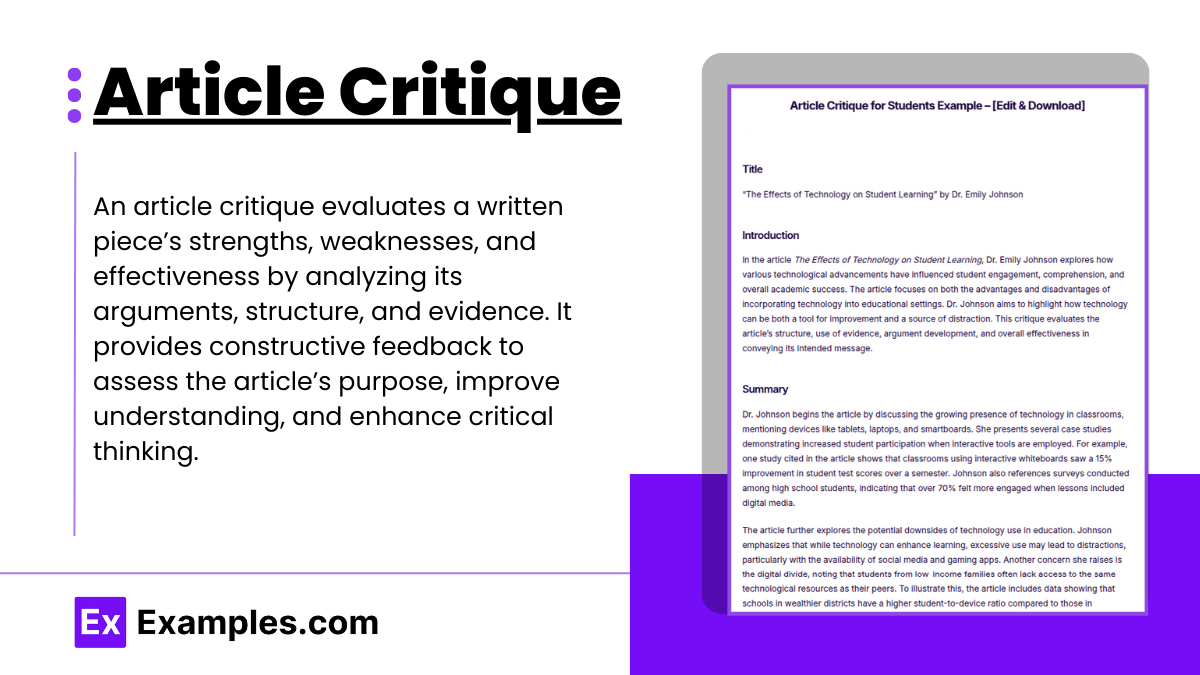15+ Article Critique Examples
An article critique is a detailed evaluation of a written piece, analyzing its strengths, weaknesses, and overall effectiveness. It goes beyond summarizing by examining the author’s arguments, structure, evidence, and writing style. The goal is to assess how well the article achieves its purpose while providing constructive feedback. A good critique highlights both positive aspects and areas for improvement, helping readers understand the article’s value and credibility. Whether for academic, professional, or personal purposes, critiquing articles sharpens critical thinking and improves comprehension
What is Article Critique?
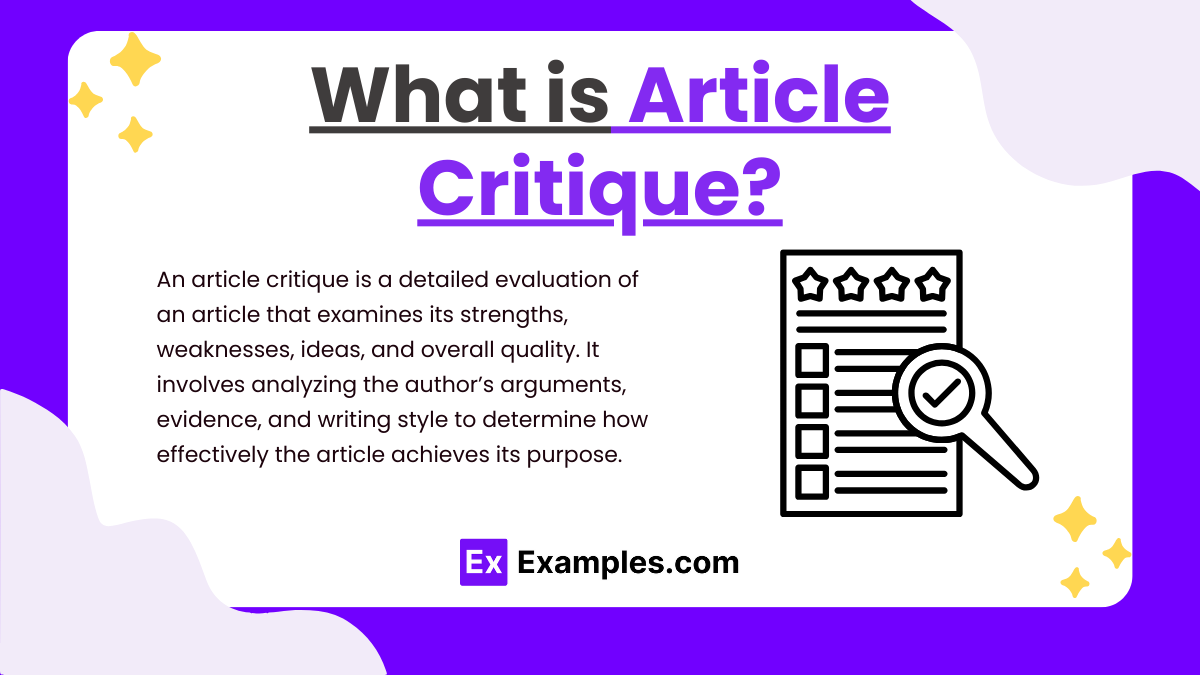
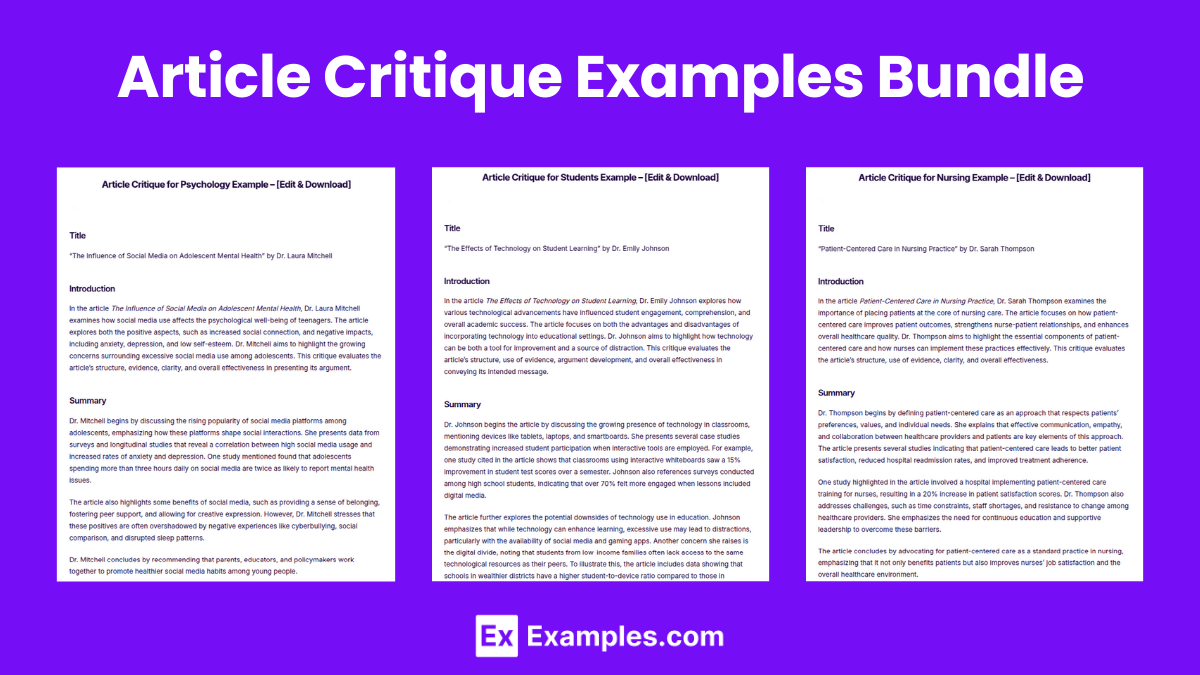
Article Critique Examples Bundle
Article Critique Format
Title
Write the full title of the article being critiqued.
Introduction
Mention the article’s title, author, and publication. State the main purpose of the article and present your thesis or main point of the critique.
Summary
Briefly describe the key points and arguments of the article, highlighting the main ideas without personal opinions.
Critique
Discuss the article’s strengths, such as evidence, clarity, and structure. Point out weaknesses, like bias, weak arguments, or poor organization. Evaluate how the author’s style and tone affect understanding.
Conclusion
Summarize your overall opinion, mention the article’s value, and suggest improvements if needed.
References
Include a full citation of the article and any other sources used.
Article Critique Example
Article Critique Examples
Article Critique for Students
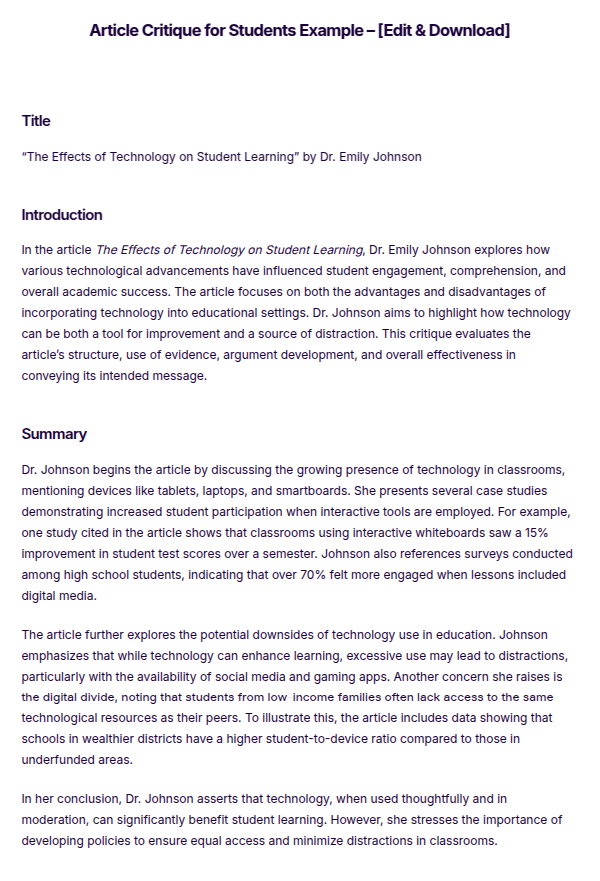
Article Critique for Nursing
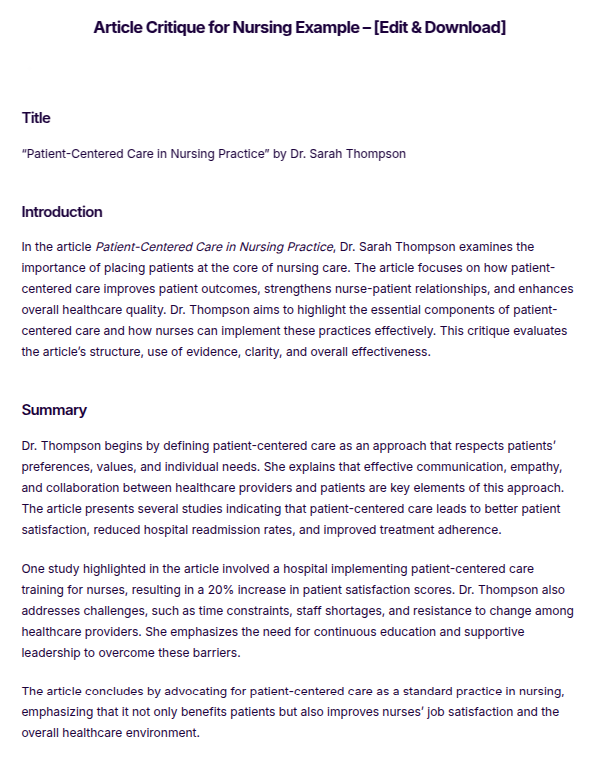
Article Critique for Psychology
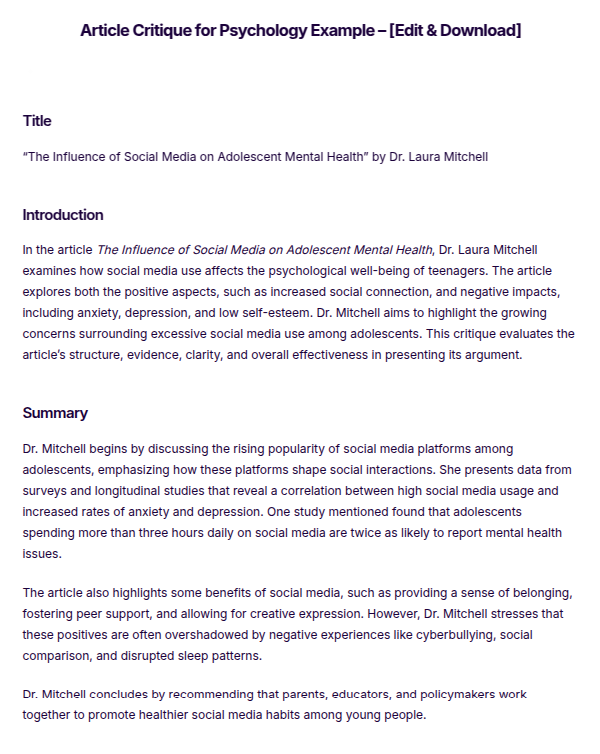
More Examples on Article Critique
- Journal Article Critique
- Nursing Research Article Critique
- APA 7th Edition Article Critique
- Research Article Critique
Article Critique Samples
Quantitative Article Critique

Critiquing Research Articles
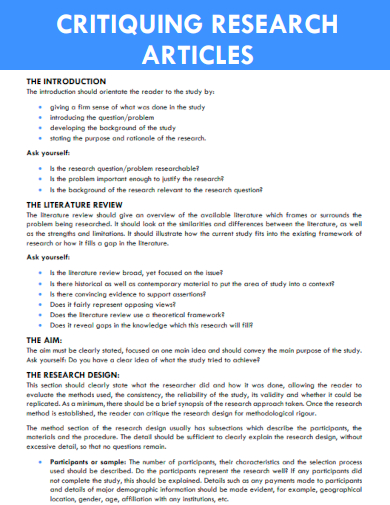
Instructions for Article Critiques
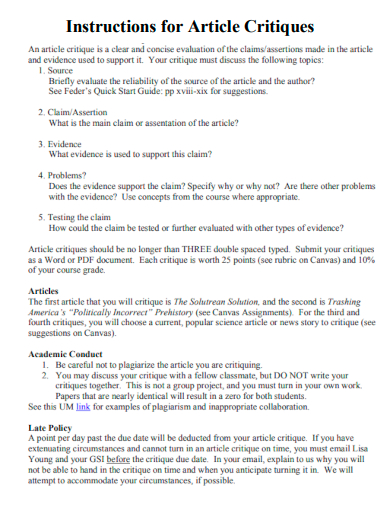
Critique of an Academic Article
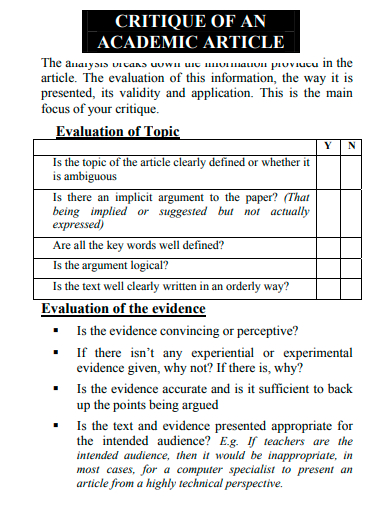
Press Article Critique
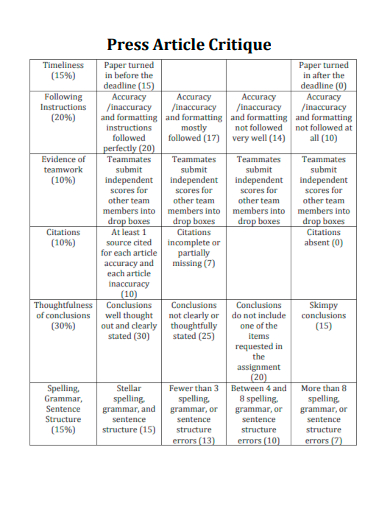
Purpose of Article Critique
An article critique serves multiple essential purposes in both academic and professional contexts. Below, we delve into the primary objectives of conducting an article critique, which are vital for developing critical thinking, analytical skills, and subject-specific knowledge.
1. Developing Critical Thinking Skills
Critical Evaluation:
- Encourages students and professionals to go beyond surface-level reading.
- Promotes a deeper understanding of the material by questioning the validity and reliability of the arguments presented.
Analytical Reasoning:
- Helps in identifying logical fallacies, biases, and unsupported claims.
- Facilitates the assessment of evidence and methodologies used in the article.
2. Enhancing Understanding of Subject Matter
In-Depth Analysis:
- Requires a thorough examination of the article’s content, including the main arguments, evidence, and conclusions.
- Enhances comprehension of complex concepts and theories within a specific field.
Contextual Awareness:
- Places the article within the broader context of existing literature.
- Identifies gaps in the research and suggests areas for further investigation.
3. Improving Academic Writing Skills
Structured Writing:
- Teaches students how to organize their thoughts coherently.
- Develops skills in writing clear, concise, and structured critiques.
Evidence-Based Arguments:
- Encourages the use of evidence to support evaluations and opinions.
- Helps in the practice of citing sources correctly and ethically.
4. Facilitating Peer Review and Feedback
Constructive Criticism:
- Provides a framework for giving and receiving constructive feedback.
- Enhances collaborative learning by engaging in discussions about the strengths and weaknesses of an article.
Quality Assurance:
- Plays a crucial role in academic publishing and professional fields by ensuring the quality and credibility of published work.
- Helps maintain high standards in research and scholarship.
5. Encouraging Lifelong Learning
Continual Improvement:
- Fosters a habit of continuous learning and improvement.
- Keeps individuals updated with the latest research, trends, and advancements in their field.
Adaptability:
- Prepares students and professionals to adapt to new information and changing paradigms.
- Cultivates a mindset that is open to questioning and re-evaluating established knowledge.
Components of an Article Critique
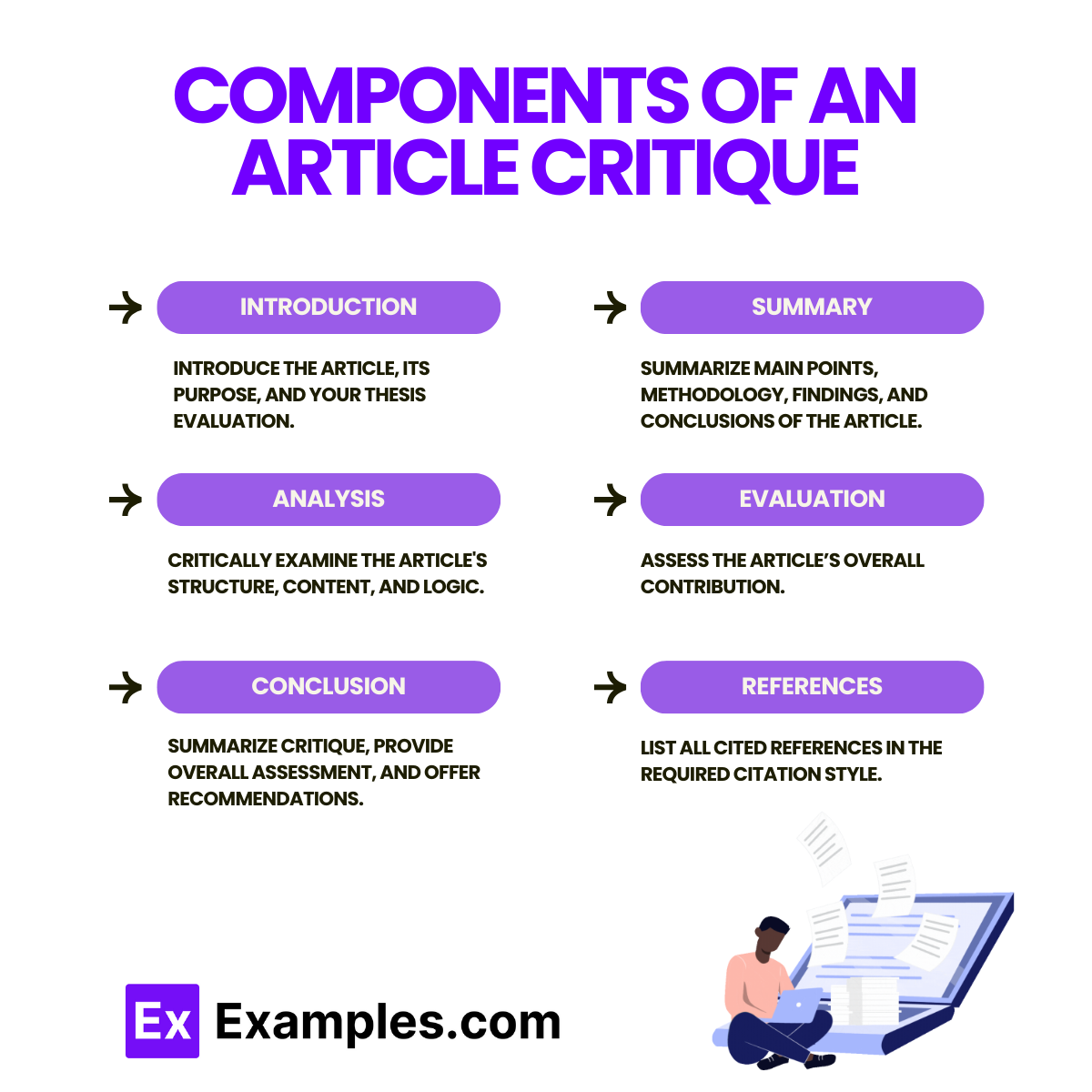
An effective article critique includes several key components to ensure a thorough evaluation and analysis. Below are the main components:
1. Introduction
Purpose:
- Provide an overview of the article.
- Introduce the main thesis and key points.
Components:
- Title and Author: State the article’s title and author.
- Publication Details: Include publication name, date, etc.
- Thesis Statement: Summarize the article’s main argument.
- Purpose of the Critique: Explain your objective.
2. Summary
Purpose:
- Summarize the article’s content.
Components:
- Main Points: Highlight key arguments.
- Methodology: Describe research methods briefly.
- Findings and Conclusions: Outline main findings and conclusions.
3. Analysis
Purpose:
- Critically examine the article’s structure, content, and logic.
Components:
- Structure and Organization: Evaluate clarity and coherence.
- Content Evaluation: Assess relevance and depth.
- Argumentation: Analyze logical flow and evidence strength.
- Methodology: Critique research methods and identify biases.
- Sources and References: Evaluate quality and relevance of cited sources.
4. Evaluation
Purpose:
- Assess the article’s overall contribution.
Components:
- Strengths: Highlight strengths such as originality and depth.
- Weaknesses: Identify weaknesses like gaps and biases.
- Contribution to the Field: Discuss the article’s impact.
5. Conclusion
Purpose:
- Summarize the critique and provide final thoughts.
Components:
- Summary of Evaluation: Recap key points.
- Overall Assessment: Provide a final judgment.
- Recommendations: Suggest future research or improvements.
6. References
Purpose:
- List sources cited in your critique.
Components:
- Citations: Format according to the appropriate style (e.g., APA, MLA).
How to Write an Article Critique

Read the Article Thoroughly
Understand the main points, arguments, and purpose of the article.
Summarize the Key Ideas
Briefly outline the article’s main arguments and findings without adding personal opinions.
Evaluate the Strengths and Weaknesses
Analyze the quality of evidence, argument clarity, structure, and any biases present.
Provide Constructive Criticism
Offer suggestions for improvement, addressing gaps, unclear sections, or overlooked aspects.
Conclude with Your Overall Assessment
Summarize your evaluation and state the article’s significance and effectiveness.
Tips for Writing Article Critique
- Understand the Author’s Purpose
Identify the main goal and key arguments of the article before critiquing. - Take Notes While Reading
Highlight important points, strengths, weaknesses, and any confusing sections. - Be Objective and Fair
Critique both the positives and negatives without personal bias. - Support Your Critique with Evidence
Use examples from the article to justify your evaluations and opinions. - Use Clear and Concise Language
Write in a straightforward manner, ensuring your critique is easy to understand.
FAQs
Why is article critique important?
It develops critical thinking, enhances understanding of the subject, improves academic writing skills, and provides constructive feedback.
What are the main components of an article critique?
Introduction, Summary, Analysis, Evaluation, Conclusion, and References.
How do I start an article critique?
Begin with an introduction that provides the article’s title, author, publication details, and a brief summary of its thesis and purpose.
What should be included in the summary?
Key points, research methods, findings, and conclusions of the article.
How do I analyze an article?
Examine the structure, content, logic, argumentation, methodology, and sources for clarity, relevance, and evidence strength.
What makes a good evaluation?
Balanced assessment of the article’s strengths and weaknesses, and its contribution to the field.
How should I conclude an article critique?
Summarize your findings, provide an overall assessment, and offer suggestions for improvement or future research.
How do I cite sources in an article critique?
Follow the appropriate citation style (e.g., APA, MLA) and ensure all references are correctly formatted.
What are common pitfalls to avoid in an article critique?
Avoid biased or overly negative reviews, lack of evidence for claims, and failure to provide a balanced perspective.
How can I ensure my critique is objective?
Use evidence to support your points, acknowledge both strengths and weaknesses, and avoid personal biases.



